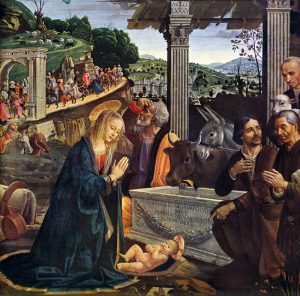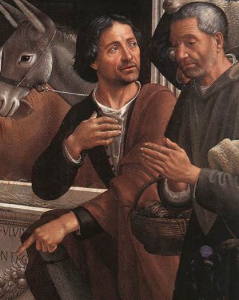It’s the most wonderful time of year again and we at AHA love to celebrate the festive season. And what better way to look at the Christmas Story than with some of Florence’s most beautiful paintings. Here are three of our favourites:
1. Fra Angelico, The Annunciation, part of the San Marco frescoes painted 1438 – 1450

The Annunciation
This fresco is found at the Convent of San Marco in Florence. Fra Angelico, a Dominican monk at the convent, painted this at the top of the stairs leading to the north corridor. The simple setting resembles the convent’s cloisters making the scene appear as an extension of the real space, as if Mary and the Angel Gabriel are before us in real life. This isn’t the only Fra Angelico painting in the convent – in fact he painted smaller scenes in each of the monk’s cells to help with their prayers and meditation.
But this is not the only reason that we try to visit it on all our student courses and adult trips.
We love this painting for its simple, understated beauty. It is an intimate holy scene, without any pomp and glory. There are no trumpets proclaiming the miraculous conception but simply the angel and the Virgin. To make this scene particularly special, Fra Angelico added sand to his pigments when painting the angel’s colourful wings so that they would sparkle in the candlelight of onlooking monks. The Virgin’s gaze is intense as the angel announces the news. They both mirror each other with their heads inclined and hands crossed over their chest, showing a mutual respect for each other – one a messenger from God, the other the Holy Mother-to-be.

Sparkly, multi-coloured wings
2. Domenico Ghirlandaio, The Adoration of the Shepherds, 1483

Ghirlandaio’s Adoration of the Shepherds
This altarpiece is nestled among some of Florence’s best frescoes which span the walls of the Sassetti Chapel in the Church of Santa Trinita. The chapel, consecrated to the birth of Christ, is decorated with Ghirlandaio’s fresco painting of the Life of Saint Francis which is often compared to the Life of Christ. It is a feast for the eyes and one of our favourite Florentine spots. The altarpiece, however, is the real jewel in the crown.
The composition of the altarpiece was so successful that it was frequently copied. Reading from right to left across the scene, you see the shepherds arriving and looking with awe at the small, innocent Christ laid on the hem of the Virgin’s mantle. The Virgin herself, a portrait of serenity and holiness, kneels to pray at Christ’s feet and lovingly gazes down at her newborn. On the winding road in the background, we can spy more visitors passing under a Classical arch on their way to visit the holy infant.

Ghirlandaio’s self-portrait as a shepherd
This painting owes much to Netherlandish painting which was being brought into Florence by merchants returning from working in the wealthy cities of Bruges, Antwerp and Amsterdam. One particularly significant import was Hugo Van der Goes’ Adoration of the Shepherds, a massive oil painting commissioned by the enormously wealthy Portinari family. Look closely and you might find some similarities with Ghirlandaio’s painting.
At this time, few artists signed their work and artists’ signatures were a little more subtle and hidden in plain sight. Often, they included a self-portrait as a sort of signature which is the case with Ghirlandaio. He has painted himself into the composition as the leading shepherd, pointing at the infant with his left hand whilst gesturing to his chest with his right hand and looking back at his fellow shepherds. This is Ghirlandaio essentially saying ‘I painted this Holy Child for you’. He even hints at his name by also pointing at the leafy garland carved in relief on the front of the sarcophagus. ‘Ghirlandaio’ was actually the artist’s nickname and it translates as ‘Garland-Maker’, referring to his father’s skill at making garlands for the hair of Florentine women. Quite arrogantly, Ghirlandaio’s position in the composition places him closer to Mary and in front of the patrons of the chapel who feature in the frescoed walls either side of the altarpiece.
3. Benozzo Gozzoli, The Procession of the Magi, 1459 – 60
This fresco cycle cannot fail to impress as you step into the small chapel located within the Palazzo Medici-Ricardi, just around the corner from the city’s famous duomo. The painted scenes fill the chapel from floor to ceiling, making the figures only slightly smaller than life-size.

The East Wall
This brightly coloured spectacle was painted by Benozzo Gozzoli. Three of the four walls depict the procession of the three kings with their gifts on their way to visit Christ. On the East wall, the end of the procession, you find a young king, the South wall is for a middle-aged king and the West wall is occupied by an old king who leads the whole company. The fourth wall, facing north, is where the chancel is located and decorated with angels and shepherds worshipping Christ.
Let’s focus on the East wall. The golden headed young king sits confidently upon his white steed which strides forward powerfully. He looks out at us and is surrounded by courtiers, archers and banner holders who proclaim his arrival. His gift to Christ, having more importance than the regent, travels in front of him in the procession and is held aloft by a horseman in the king’s company.

Gozzoli’s self-portrait
Look closely at the crowd following behind in the detail below. Each figure is highly individual and they are, in fact, portraits of people known to the Medici, who favoured this biblical story and have included themselves in the fresco as well. Note the gentleman wearing a red hat, riding on a white horse just behind the young king. This is the donor of the chapel, Piero de’ Medici. And behind him, on the brown mule (recognisable by its large ears) is Cosimo ‘Il Vecchio’ de’ Medici, the grandfather of the family. There are a number of other recognisable faces within the whole fresco, including another self-portrait of the artist. At the back of the crowd, behind the Medici, you’ll spot him in the red cap on which he has taken the liberty of writing his name so there’s no mistaking him!

Detail of the East Wall with the Young King and the Medici behind
So there is the Christmas Story as depicted by the Florentines some 500 years ago. They are paintings which still amaze us every time we visit them. May your Christmas be as magical as the Fra Angelico, as memorable as the Ghirlandaio and as colourful as the Gozzoli. We hope you’ll join us on a course next year to see these fabulous works for real.
P.S. The featured image is a detail of the Young King from the East Wall of Gozzoli’s fresco, discussed above.

